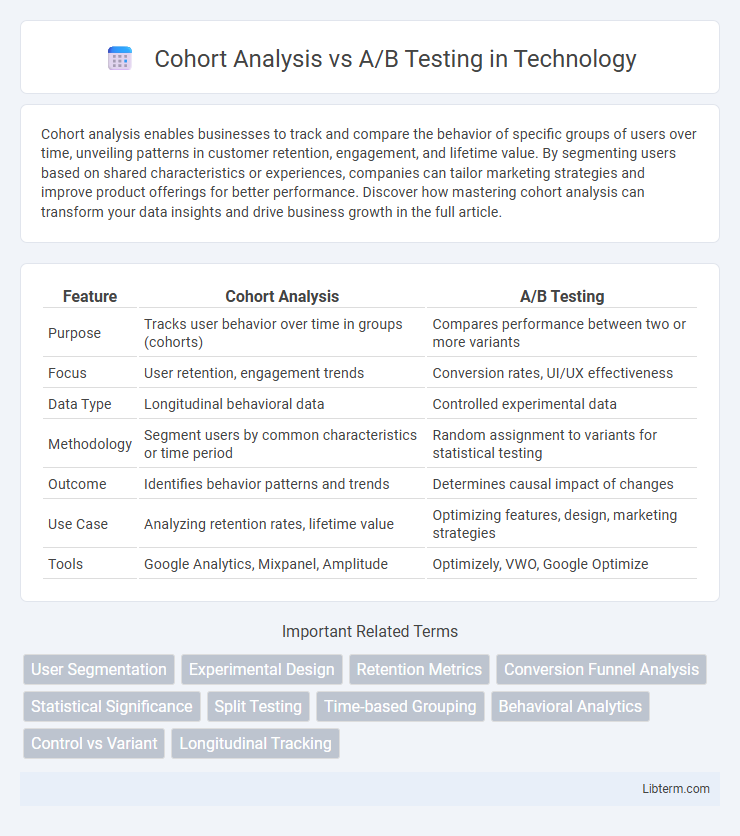Cohort analysis enables businesses to track and compare the behavior of specific groups of users over time, unveiling patterns in customer retention, engagement, and lifetime value. By segmenting users based on shared characteristics or experiences, companies can tailor marketing strategies and improve product offerings for better performance. Discover how mastering cohort analysis can transform your data insights and drive business growth in the full article.
Table of Comparison
| Feature | Cohort Analysis | A/B Testing |
|---|---|---|
| Purpose | Tracks user behavior over time in groups (cohorts) | Compares performance between two or more variants |
| Focus | User retention, engagement trends | Conversion rates, UI/UX effectiveness |
| Data Type | Longitudinal behavioral data | Controlled experimental data |
| Methodology | Segment users by common characteristics or time period | Random assignment to variants for statistical testing |
| Outcome | Identifies behavior patterns and trends | Determines causal impact of changes |
| Use Case | Analyzing retention rates, lifetime value | Optimizing features, design, marketing strategies |
| Tools | Google Analytics, Mixpanel, Amplitude | Optimizely, VWO, Google Optimize |
Introduction to Cohort Analysis and A/B Testing
Cohort analysis segments users into groups based on shared characteristics or behaviors, enabling businesses to track performance and trends over time to identify patterns and improve customer retention. A/B testing compares two or more variations of a webpage, app feature, or marketing campaign to determine which version yields better user engagement or conversion rates through controlled experiments. Both techniques provide data-driven insights but serve different purposes: cohort analysis focuses on behavioral segmentation over time, while A/B testing isolates the impact of specific changes on user actions.
Defining Cohort Analysis
Cohort analysis is a data-driven technique that segments users based on shared characteristics or experiences within a specific timeframe to observe behaviors and trends over time. Unlike A/B testing, which compares two or more variants simultaneously to determine the most effective option, cohort analysis tracks the performance and retention of distinct user groups, enabling deeper insights into user lifecycle and long-term engagement. This method is essential for understanding how specific segments respond to changes or campaigns, facilitating targeted strategies and improved customer retention.
Defining A/B Testing
A/B testing is a controlled experiment that compares two or more variants to determine which performs better based on key performance indicators such as conversion rates or user engagement. It involves randomly assigning users to different groups to isolate the impact of a single variable on behavioral outcomes. This method provides statistically significant insights that guide data-driven decisions in marketing, product development, and user experience optimization.
Key Differences Between Cohort Analysis and A/B Testing
Cohort analysis segments users into groups based on shared characteristics or behavior over time to track performance and trends across different periods. A/B testing compares two or more variants of a single element to determine which version yields better results by isolating variables in a controlled experiment. Cohort analysis emphasizes longitudinal insights and behavioral patterns, while A/B testing focuses on immediate cause-and-effect relationships to optimize specific metrics.
Common Use Cases for Cohort Analysis
Cohort analysis is primarily used to track user behavior and retention over time, identifying patterns within specific groups based on their acquisition date or actions. It excels in understanding long-term customer engagement, churn rates, and the impact of product updates on distinct user segments. This method provides granular insights for optimizing marketing strategies and improving customer lifetime value by analyzing how cohorts respond differently to various features or campaigns.
Common Use Cases for A/B Testing
A/B testing is commonly used to optimize website design, email marketing campaigns, and user interface changes by comparing two versions to determine which performs better. It helps businesses increase conversion rates, improve user engagement, and validate new product features through controlled experiments. Unlike cohort analysis, which tracks groups over time for behavior trends, A/B testing provides immediate, actionable insights on specific variations.
Metrics: What to Measure and Compare
Cohort analysis measures user behavior by grouping users based on shared characteristics or events over time, tracking metrics such as retention rate, churn rate, and lifetime value within these cohorts. A/B testing compares different versions of a variable, focusing on conversion rates, click-through rates, and engagement metrics to identify which variant performs better. Both methods require clear metric definitions, but cohort analysis emphasizes longitudinal trends while A/B testing prioritizes comparative performance at a specific point in time.
Advantages and Limitations of Cohort Analysis
Cohort analysis provides granular insights by grouping users based on shared characteristics or behaviors over time, enabling businesses to track retention, engagement, and lifetime value more accurately than broader testing methods. Its advantages include the ability to identify long-term trends and user segments, facilitating targeted strategies for improving customer experience and maximizing revenue. However, cohort analysis can be limited by slower data collection, potential cohort overlap, and challenges in isolating variables compared to the controlled experimentation environment offered by A/B testing.
Advantages and Limitations of A/B Testing
A/B testing offers precise, data-driven insights by comparing two variants to determine which one performs better, making it ideal for optimizing user experience and conversion rates. Its limitation lies in the need for large sample sizes and sufficient time to achieve statistically significant results, which can delay decision-making. A/B testing may also oversimplify variables, potentially missing deeper user behavior patterns that cohort analysis reveals.
Choosing the Right Method for Your Business Goals
Cohort analysis excels at tracking user behavior and retention over time by segmenting groups based on shared characteristics, making it ideal for understanding long-term trends and customer lifecycle value. A/B testing is better suited for optimizing specific features or marketing campaigns by comparing variant performance in real-time, providing actionable insights for immediate decision-making. Selecting the right method depends on your business objectives: use cohort analysis for strategic growth and retention insights, and A/B testing for testing hypotheses and driving short-term conversions.
Cohort Analysis Infographic

 libterm.com
libterm.com